 CS 596: Client-Server Programming
CS 596: Client-Server Programming
Spring Semester, 1997
Doc 3 Networks
To Lecture Notes Index
San Diego State University -- This page last updated Feb 4, 1997

Contents of Doc 3 Networks
- References
- Networks
- How Information is Transmitted in a Network
- Store-and-Forward Packet-Switching Networks
- Multiple-Access Networks
- Classes of Communication Services
- ISO OSI Model
- Physical Layer
- Data Link Layer
- Network Layer
- Transport Layer
- Session Layer
- Presentation Layer
- Application Layer
- Our View of Network Communication with TCP/IP
Communication Networks: A First Course by Jean Walrand, 1991, chapters 2 - 4,
6, 7
Unix Network Programming by W. Richard Stevens, 1990, selected pages
Internetworking with TCP/IP Volume 1 Principles, Protocols, and Architecture,
Third Edition, by Douglas E. Comer, selected pages
RFC 1700, Assigned Numbers by J.Postel
Point-to-point
- Dedicated link between two computers
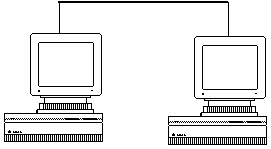
Communication Network
- A set of communication nodes that are interconnected to permit the exchange
of information

StringNet
Information transferred to medium
Network Protocols - handshaking
Duplex
Store and forward
Flow control
Routing
Outline
Types of networks
- LAN
- WAN
- Store and forward
- Multiple-Access
Routing
Switching
Types of service
ISO - OSI
TCP/IP
Information is transformed into electrical or optical signals
All signals are corrupted during transmission
Transmission adds noise to the signal
Digital data helps over come noise
-
- Slightly corrupted 1's are distinguishable from slightly corrupted 0's
-
- Digital data allows for error-control
Dynamic data like audio or video normally requires continuous transmission
Packets
Stream of bits is divided into separate packets
Kermit Packet Structure

Mark
- Start of packet, usually control A
Len
- length of packet in ASCII characters
Seq
- Packet sequence number mod 64
Type
- D = data
- Y = acknowledge (ACK)
- N = negative acknowledge (NACK)
- S = send initiate
- R = receive initiate
- etc.
Data
- The data if any
CKS
- Checksum
Student Net
Show:
- Packet order
-
- Lost packets
-
- Multiplexing of channels
Routing
- What paths should the packets follow in the network
Flow Control
- How to regulate the flow so parts of the network don't become
congested
Addressing
- How to specify addresses of devices on the network
Security
- Maintain privacy of information on the network
Standards
- Needs standards to allow multiple vendors to build compatible hardware and
software
Presentation
- Enable many different types of terminal equipment to communicate
Switching
Circuit switching
-
- A direct line between to users is established
-
- The users "own" the line until they drop the connection
-
Virtual - circuit switching
-
- All packets of a stream follow the same route
-
- Used by ATM (Asynchronous Transfer Mode )
-
Datagram packet - switching
-
- Each packet is routed individually
-
- All packets of a stream may or may not take the same route
-
- Used by TCP/IP
Multiple computers share a single communication channel
Examples
- Ethernet
- Token Ring
- Appletalk
- Starlan
Multiplexing - How to share a communication channel
- Frequency - Division Multiplexing ( FDM )
-
- Assign different frequencies to different users
-
-
- Time - Division Multiplexing ( TDM )
- Divide the time into small slices
- Each user gets every N'th time slice
- Statistical Multiplexing
-
- Give each user a label
- Mark packets with label
- Mix packets from different users on channel
-
Local Air Net
Show:
- FDM
- TDM
End-to-end services as seen by the users:
Synchronous communications
- Bit stream is delivered with a fixed delay and given error rate
-
- Each bit reaches the destination with the same time delay after leaving the
source
Asynchronous communications
- Bit stream is divided into packets
-
- Packets are received with varying delays, so packets can arrive out of order
-
- Some packets are not received correctly
-
- Connection-oriented
- Packets are delivered in order
-
- System confirms delivery and put packets in order
-
- Error free
-
- Connectionless
- Packets are treated individually
-
- Program has to worry about order, error and lost packets
- Expedited Data
- Faster delivery than normal
ISO - International Organization for Standardization
OSI - Open Systems Interconnection reference model
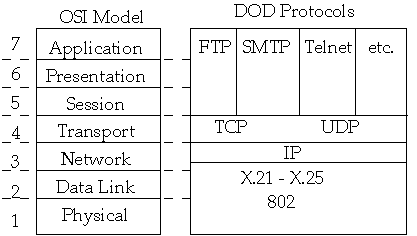
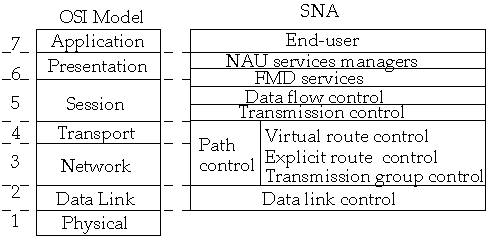
Transform bit to signal and signal to a bit
Medium used to transmit signal
- radio,
- twisted pair
- coaxial cable
- optical fiber
Issues
- Noise
- Attenuation - signal decreases in strength
- Dispersion - signal changes
- Echoes
Examples
- modems
- RS-232
- V.24
Makes sure that a packet arrives properly between two ends of a wire
ACK -acknowledgment of packets
Error detection
Store and forward
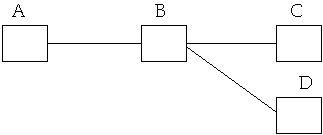
Deals with getting a packet from the source node to destination node in the
network
Issues
- Routing
- Congestion
- Addresses of physical devices

Controls the delivery of messages between the end nodes in the network
Issues
- Divide message into packets
-
- If required reorder packet that arrive out of order
-
- If required resend lost or damaged packets
-
- End to end flow control
-
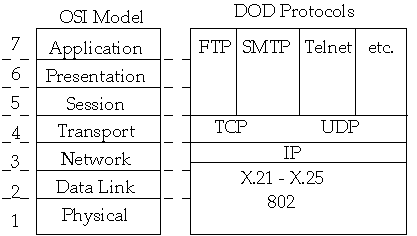
Negotiates the rules used in the session
Full duplex or half-duplex, etc.
Syntax translation between computers
Byte order
Encryption
Data compression
Whatever the program was designed to do
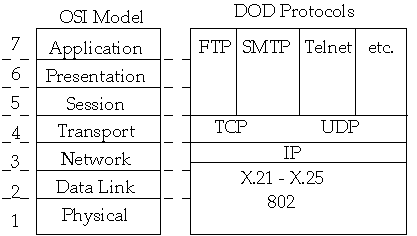
TCP - Connection-oriented
UDP - Connectionless
TCP gives us a "pipe" between machines to allow us to send messages between
machines
Addresses and Names
IP address is a 32 bit number
- 130.191.226.1
Machines on a network need a unique IP address
Domain Name System ( DNS )
- rohan.sdsu.edu
| Domain Names | Meaning |
| COM | Commercial organizations |
| EDU | Educational institutions |
| GOV | Government institutions |
| MIL | Military groups |
| NET | Major network support groups |
| ORG | Organizations not list above |
| ARPA | obsolete |
| INT | International organizations |
| country codes | 2-letter code per country |
IP addresses and names are assigned by Internic
Ports
Each TCP/IP machine has multiple logical communication channels called ports
Ports are numbered from 0 - 65536
A connection between two machines is uniquely defined by:
- the protocol (TCP or UDP)
- the IP address of local machine
- the port number used on the local machine
- the IP address of remote machine
- the port number used on the remote machine
| reserved port numbers | 1 - 1023 |
| port numbers used by system | 1024 - 5000 |
Some Interesting Servers
| Service | Port Number |
| echo | 7 |
| discard | 9 |
| character generation | 19 |
| daytime | 13 |
| time | 37 |
| telnet | 23 |
| gopher | 70 |
| WWW | 80 |
See RFC 1700 for a complete list for reserved ports and services they
provide
Telnet a Simple Client
On rohan type:
- telnet saturn 13
Or try:
- telnet rohan 80
-
- then type anything followed by <CR>
Or try:
- telnet rohan 80
then type:
- GET / HTTP/1.0 <CR>
- . <CR>
- <CR>
RFC's
Request for Comments define the internet protocols
See:
http://www.yahoo.com/Computers_and_Internet/Standards/RFCs/
http://www.cis.ohio-state.edu/hypertext/information/rfc.html
 CS 596: Client-Server Programming
CS 596: Client-Server Programming CS 596: Client-Server Programming
CS 596: Client-Server Programming







